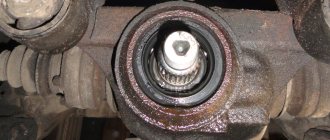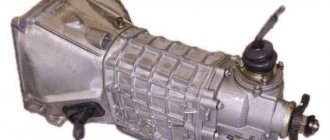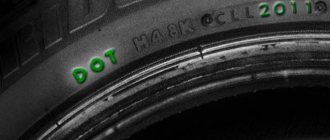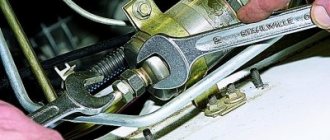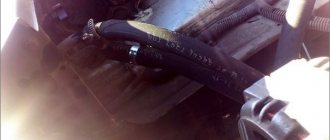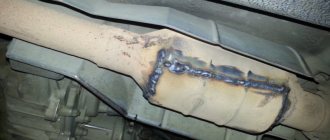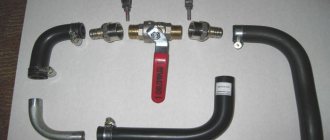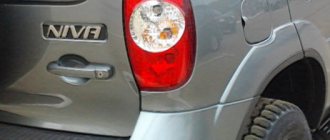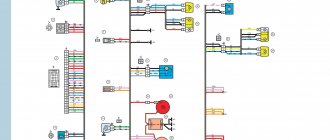Chevrolet Blazer “Astrakhambovsky” Wolf › Logbook › You are my breathers, breathers…
I decided to write wisely (I’ll explain in the blog why exactly this way and not otherwise)
Quote: The principle of operation of the breather
A decrease in the oil level in the tank leads to the creation of a vacuum in it. The difference in pressure in the tank and in the atmosphere provokes the creation of an air flow, which, passing through the filter element, is cleaned of mechanical impurities and enters the tank above the oil level. When the oil level in the tank rises, the air displaced from it is released into the atmosphere through the filter element.
Now not a quote:
The breather is the outlet from the axles, automatic transmission and transfer case through which they “breathe”. During operation, the oil heats up and expands with the air. Pressure is created, which, if not relieved, will begin to press oil through the gaskets, and this is not good. The opposite effect - when cooling inside, the pressure drops and the container (axle, gearbox, transfer case) begins to try to suck air into itself through the same gaskets. Which is also not gut. Because at that time the car was being operated in a layer of DIRT and WATER (otherwise why would sudden cooling suddenly occur?) So to prevent this from happening, breathers were invented. In the future I will say – breather, meaning the breather itself, the hose, and all sorts of mounting and exiting places.
Why the hell are they really needed:
And they are needed to prevent water and other liquid (semi-liquid) substances from getting inside the power units. This is the first one. And secondly, prevent the gaskets from being squeezed out due to excess pressure and, as a result, de-oiling of the unit.
In short, even clean water that gets into the oil forms an emulsion that is not suitable for lubricating and protecting the components of the unit (I drained just this from the front axle). If another fluid gets into the axles and transfer case, we can get away with a slight fright, by washing and changing the oils, then the automatic transmission will go into emergency mode (the letter “N” flashes) and we will be sent to repair the automatic transmission, which costs... in short, it costs)) Notation: If cars roll on asphalt and in sunny weather - there’s no need to bother with removing the breathers. And if it is used to its fullest extent, in order to extend the life of the axles, gearboxes and transfer cases, it is imperative to move the breathers higher.
Background:
Climbing under the bottom for a long time, I did not ignore the various tubes hanging and crawling in different directions in a chaotic direction. Having traced the routes of movement and consulted with authoritative people, I came to the conclusion that we must do it wisely. The car was planned for “poaching” revelry – namely fishing and country rides. And there, as you know, there is water right at the bottom. Basically, the breather system consists of tubes going somewhere into the frame. Therefore, immersion in water above the frame is DANGEROUS.
BUT! We sometimes roll cars exactly ON THE FRAME. And this leads to rapid contamination of the breathers and, as a result, they stop working correctly, releasing excess pressure or eliminating vacuum.
Conclusion:
We push the tube outlets as high as possible.
The optimal place is a snorkel. The second place essentially is under the hood, you just need to try not to dive deeper)))). Well, in principle I didn’t intend to, so I stopped under the hood. DO NOT TAKE OUT TO THE SALON!
Comrades, why the hell are you having health problems? The evaporation of technical oil in units is never the same as evaporation from sunflower oil!
Consumables, some kind of useful tool and other thoughts:
People advise, The main thing is an oil-resistant hose with a diameter of 6mm = 10m [50 rubles per meter], or a hose d=8mm. oil and petrol resistant 1 m (in braided durite) (depending on the size of the breather tube - whatever fits, then take it) code - 091467, article - SHMBS-8X1000, price - 90 rubles. per meter or hose from the construction water level (in construction stores). I’ll be honest, I looked at it, it looks unsightly, but it’s cheap - it’s a transparent tube like a dropper, but much thicker. 200 rubles for 5 meters.
The principle of operation of the breather in the engine
Today, a breather valve to reduce pressure is very often installed on SUVs. This is because the device is suitable for off-road driving and prevents oil leakage. Heated engine oil expands, causing engine pressure to increase.
The pressure in engines or in other automotive devices must find a way out. This causes oil to leak out through various gaskets and gaps. To prevent oil leakage, breather valves are installed.
All breathers in the car should be checked periodically. Due to the constant movement of oil, debris and dirt remain in it. The valve must be properly removed and cleaned of contaminants. If it is too dirty, then it must be replaced with a new device. Before installing a new valve, be sure to thoroughly clean the installation area of dirt and debris. This is done to prevent debris from getting into the new device.
Breather operating principle
The breather valve prevents oil leakage from the crankcase. The breather releases air and gases that form the cylinders of the head unit. This happens due to the intake of air from the atmosphere after the driver stops and turns off the ignition. The breather also prevents dirt from getting inside the engine, which is why they are widely used on SUVs.
Like other mechanisms, breathers are prone to clog and accumulate dirt, as well as malfunction. Devices need to be checked periodically and measures taken for timely replacement. Operation of damaged or clogged engine breathers leads to deterioration in operating efficiency and excess pressure in the internal plane. The oil from the crankcase is just waiting for this, preparing its escape. And this absolutely cannot be allowed.
During active driving, the main structural elements of the car heat up. Accordingly, the pressure of the heating oil increases. The chain leads to an increase in air pressure inside the crankcase. If it is not promptly reset, the liquid will fly out. When cooling, the oil pressure drops, which also complicates the normal operation of important vehicle systems during startup and acceleration.
Today, a breather valve to reduce pressure is very often installed on SUVs. This is because the device is suitable for off-road driving and prevents oil leakage. Heated engine oil expands, causing engine pressure to increase.
Read more: Repairing a crack in a plastic bumper: soldering, gluing and welding damaged areas
The pressure in engines or in other automotive devices must find a way out. This causes oil to leak out through various gaskets and gaps. To prevent oil leakage, breather valves are installed.
All breathers in the car should be checked periodically. Due to the constant movement of oil, debris and dirt remain in it. The valve must be properly removed and cleaned of contaminants. If it is too dirty, then it must be replaced with a new device. Before installing a new valve, be sure to thoroughly clean the installation area of dirt and debris. This is done to prevent debris from getting into the new device.
A car uses a large number of components and assemblies, inside of which there are technical fluids and lubricants. During operation, such liquids heat up, that is, they increase in volume and the pressure inside increases.
Taking into account the fact that the systems and units themselves are sealed, closed (there is no direct communication with the atmosphere), pressure differences occur inside relative to atmospheric pressure. This difference must be equalized to prevent depressurization, leaks and damage.
For this reason, the engine cooling system has a special valve, which on modern cars is located in the cap of the expansion tank. As for the internal combustion engine or gearbox, a similar function is performed by the engine breather and the breather on the gearbox. Next, we will look in detail at what a gearbox breather is, why it is needed, and how this element is designed and works.
So, in order to understand what a breather is in a car, it should be noted that in fact it is a valve that allows you to reduce the pressure in the crankcase of a sealed unit (engine, gearbox, etc.) A breather, breather or breathing valve is a device through which the container communicates with the atmosphere, and even taking into account the temperature difference in the container, it is possible to maintain atmospheric pressure.
As you know, the gearbox performs the task of converting torque from the engine, after which torque is transmitted to the drive wheels. The box itself is filled with transmission oil, which tends to heat up during operation of the gearbox, expanding in volume. The result is an increase in pressure that needs to be relieved.
It is not difficult to guess that oil leaks from the gearbox will lead to the lubrication level dropping, the box will begin to work poorly, and will also wear out quickly and actively. First, the driver experiences difficulties and discomfort (gears engage worse), then extraneous noise appears (hum, vibration of the box), then synchronizers, bearings, gears and other gearbox elements fail. In the gearbox, the breather is installed on the gearbox housing cover.
- Let us add that breathers are also installed on the engine (engine breather), on the transfer case, gearboxes, and axles. As for the internal combustion engine, the pressure in the unit grows quite actively, as strong heating occurs, some of the exhaust gases inevitably break into the crankcase, etc. To avoid oil leaks as a result of increased pressure, said pressure is “released” through the breather.
Read more: Reverse gear on VAZ-2109 does not engage: reasons, repairs
Another important function of the box or axle breather, as well as the engine, is protection from dust, dirt, water, etc. This is especially true for car axles, since the bridge is an open element (for example, on an SUV) and can be submerged in water or mud when driving through difficult areas.
Breather in gearbox
The gearbox must convert the torque in the engine and also change the traction force. It often happens that the gearbox starts to work poorly due to the fact that the gearbox breather is clogged. To avoid any damage, you should clean not only the breather in the engine, but also all the others that are installed in different parts of the machine.
In a gearbox, the bypass valve is located on the gearbox housing cover. The ingress of sand or dirt will cause the wheel mounted on the secondary shaft to jam. As a result, wear of bearings and synchronizers increases. It is necessary to wash the breather during each technical inspection, or even more often. If the valve is clogged, the pressure in the gearbox will increase, which will lead to oil leakage through the seals.
5.7.2 Checking the tightness of the rear axle seals
Check the tightness of the seals by external inspection. It is more convenient to check from below the car, mounted on a lift or inspection ditch. Listed below are places where oil may leak.
1. Drain plugs 1 and filler 2 holes.
NOTE If oil leaks from under the plugs, tighten them.
2. Connector on the gearbox flange.
NOTE “Sweating” around potential leakage areas is acceptable. The formation of droplets is not allowed.
USEFUL TIPS If oil leaks from under the gearbox flange, tighten the bolts securing the gearbox to the rear axle housing. If there is oil leakage from under any gearbox mounting bolt that is not corrected by tightening the bolt, install a soft metal (aluminum) washer under the head of the bolt or apply a thin layer of sealant to the threaded part of the bolt.
3. Drive gear oil seal.
4. If the axle shaft seal fails, it leaks here.
5. Oil leakage from the seals can be caused by a clogged breather (see “5.7.1 Design features of the rear axle”). If traces of oil leakage are found, clean the breather from dirt, check the freedom of movement of the breather cap in all directions, carefully wipe the leakage areas and inspect them again after driving 20–30 km. If traces of leakage are found again, it is possible that the breather is clogged and in the rear axle crankcase, when it heats up during operation, pressure increases, squeezing oil out of the seals. Unscrew the breather and clean it. If, even after cleaning, oil leaks from the seals are observed, replace the breather, as it may be faulty (the valve is stuck). If even if the breather is working properly, oil still leaks from the seals, replace the seals.
Bridge breathers
There is oil inside each axle that connects the wheels. The internal cavity must be in contact with the external environment, and it does this through the valve. With the help of this valve, an increase in pressure inside the bridge itself is eliminated.
Oil pressure rises when it heats up during forward gear operation. The breather also performs a protective function. It protects the bridge from water entering it when the car overcomes a water barrier. There is also a special hole in the middle of the bridge through which oil drains.
Particular attention should be paid to the rear axle crankcase breather. It is located on the rear axle boat, on the right side, in the upper part. As a result of this valve being clogged, oil may leak. To get rid of this problem, you need to clean it of dirt. You also need to check the free movement of the breather cap. It should move in all directions.
After cleaning, you should check it again after a short run of 20 km. If traces of oil are detected again, this will indicate a malfunction of the device that needs to be replaced. The rear axle breather must always be in good condition, because it plays an important role in the operation of the entire vehicle.
Engine breather: what is it?
Many novice motorists often hear the expression “engine breather,” but not everyone knows what it is and what it is needed for. This article will talk about what an engine breather is, its installation locations and its main purpose.
Content
What is a breather and its main purpose?
Engine breather, what is it?
In order to answer this question, you need to understand its purpose. A breather (breathing valve) is a device through which a closed container communicates with the atmosphere, thereby maintaining the required pressure. During the operation of the engine, various gases accumulate in it, and if they are not released in time, then the operation of the internal combustion engine may stop, and the breather is responsible for this. In other words, it maintains the required pressure inside the engine crankcase. By itself, it performs the function of a valve, which, at increased pressure, bleeds air from the engine. In a car, this device is installed in the following places:
- ICE.
- Checkpoint.
- Front bridge.
- Rear bridge.
Now it’s worth considering the installation location in more detail.
Breather installed in an internal combustion engine
Most often, the device is located next to the oil filler neck; a hose comes from the outlet pipe, which is connected to the air filter housing. Also, in addition to controlling the required pressure, the breather prevents the engine device from getting dirt and moisture into it. Due to the fact that oil constantly circulates through it, dirt and dust accumulate in it, so it is necessary to monitor its normal operation and clean it on time.
There is an expression “engine breather”, which manifests itself in the fact that exhaust-like smoke pours out of all open openings of the internal combustion engine, and at the same time, oil and fuel consumption increases. The main reasons for this malfunction may be:
- occurrence of piston rings;
- contamination of the ventilation system;
- malfunction of the cylinder-piston group.
The consequences that such a breakdown can lead to: rupture of the crankcase exhaust hose, rupture of the valve cover, breakdown of internal combustion engine parts (engine knocking), and there have also been cases when the pan was torn out.
In case of such breakdowns, we will immediately talk about expensive repairs, and sometimes you will even have to buy a new engine. By the way, today it is possible to buy a contract engine. This is a type of used internal combustion engine that was brought from abroad and has not been driven in our country.
Breather in gearbox
Why do you need a breather in the gearbox? Just like with an internal combustion engine, this device is designed to control the pressure in the unit. If the “breathing valve” is heavily contaminated, this will affect the operation of the gearbox, and as a result, the wear of bearings and synchronizers will increase. Also, if the valve is severely clogged, the pressure in the gearbox will increase, and as a result, oil will begin to leak through the seals.
Breather in bridges
There is also oil inside the axles connecting the wheels, and for their normal operation and maintaining optimal pressure, a breather is also provided. This mechanism acts as protection against dirt and moisture getting inside while the car is moving. If the valve is significantly clogged, the oil inside the bridge will leak. In order to prevent this, you should clean the breather and check that its cover moves in all directions.
Preventative work
Some motorists are wondering: why clean the breather? This is done in order to avoid problems with the operation of car components; it is necessary to clean the breather in a timely manner. Such actions will allow you to maintain the permissible pressure level, and as a result, stable and trouble-free operation of the car. It is recommended to carry out cleaning at every technical inspection (MOT), and in some cases even more often. The cleaning process itself looks like this:
- removal of pipes and hose. All pipes and hoses coming from the “breathing valve” are removed; in some models you will also need to remove the air filter housing;
- removing the breather cover;
- cleaning work. Now you can begin cleaning the valve cap and tube.
- installation work. Assembly is carried out in reverse order.
This is how cleaning is done. The procedure is quite simple, and you can do it yourself with your own hands, without the need to visit a service center.
Bottom line
Based on all the above information, it is time to draw conclusions. The breather in a car engine plays an important role for its stable and normal operation. And in order to avoid problems with its operation, it is necessary to carry out preventive cleaning of accumulated oil in a timely manner. If this is done in a timely manner, then there will be no problems with the operation of the engine.
Best regards, Maxim Markov!
carsmotion.ru
Breather: description, purpose, cleaning, installation, photo, video.
An engine breather (breathing valve) is a device for equalizing the pressure in a closed container relative to atmospheric pressure. In other words, the breather valve allows the closed container to communicate with the atmosphere. In internal combustion engines, the breather equalizes the pressure inside the engine crankcase.
During the operation of the vehicle and the operation of the power unit, the pressure in the crankcase may increase, as a result of which crankcase gases escape through the breather, excess engine oil is squeezed out, etc. If the pressure in the engine crankcase is below atmospheric pressure, then outside air enters the crankcase through the breather, thereby eliminating the difference between external atmospheric and internal pressure in the crankcase cavity.
Engine breather: what is it?
An engine breather (breathing valve) is a device for equalizing the pressure in a closed container relative to atmospheric pressure. In other words, the breather valve allows the closed container to communicate with the atmosphere. In internal combustion engines, the breather equalizes the pressure inside the engine crankcase.
During the operation of the vehicle and the operation of the power unit, the pressure in the crankcase may increase, as a result of which crankcase gases escape through the breather, excess engine oil is squeezed out, etc. If the pressure in the engine crankcase is below atmospheric pressure, then outside air enters the crankcase through the breather, thereby eliminating the difference between external atmospheric and internal pressure in the crankcase cavity.
We also recommend reading the article about what EGR is. From this article you will learn about the design, purpose and operating principles of the exhaust gas recirculation system.
Read in this article
Where is the breather installed?
Breathers on a car are installed:
- in the engine itself;
- in the gearbox device;
- in the design of the front and rear axles;
Note that the functions of these devices are almost the same regardless of the installation location. It should be added that the valve also has an additional filter that prevents mechanical particles, dirt and moisture from entering the engine along with the outside air.
To put it differently, the breather allows those components to “breathe” from which the working fluid cannot leak out, as well as water and dirt from entering from the outside. During operation of the internal combustion engine, the engine oil in the crankcase heats up, which causes it to expand. The air in the crankcase also expands and pressure is created. If this pressure is not relieved, then the oil will begin to squeeze out through the seals, seals and gaskets of the engine. This statement is also true in relation to other components of the car (axles, transfer case, gearbox).
After stopping the engine and stopping the operation of other components, as well as when it gets into water (important for SUVs), cooling occurs. When cooling, the pressure in the container drops, a pressure difference arises again and outside air tries to break through through the gaskets, etc. To counteract these phenomena and safely equalize pressure on the engine, gearbox, etc. breathers are installed. It turns out that the valve prevents water and dirt from entering the power units when the pressure drops, and also does not allow the gaskets to be squeezed out and the working fluid (lubricant) to leak out when excess pressure occurs.
Purpose
What is an engine breather? Before answering this question, it is important to understand what it is intended for. This is directly related to the principle of its operation. The main task of this device is to reduce the pressure in the engine crankcase. When the power unit operates, various gases collect in the crankcase. Gradually they accumulate and create quite a lot of pressure. If you do not bleed them, the engine may stop, the pressure will back up the pistons.
In this case, the gas will seek an exit through any available hole. To prevent this from happening, a breather is installed. This device is also used to ventilate the crankcase. Unnecessary gases are removed from it. Thus, the temperature inside the engine is slightly reduced. The engine breather has two tasks: ventilation and releasing excess pressure. In some cases, the operation of the breather can indicate the presence of problems in the engine. If the rings are stuck or the piston is damaged, gray smoke characteristic of the exhaust will fly out of the hose. This way you can diagnose these faults without disassembling the engine. In normal condition, a slightly noticeable transparent smoke comes out of the breather.
Why do you need to clean the valve?
The external conditions created during the operation of the breather valve often lead to the accumulation of dust and dirt in it, which interfere with its normal functioning. Because of this, excess or, conversely, insufficient pressure occurs, leading to oil leakage. If situations arise when oil is thrown through the unit, first of all you should check whether it is clogged. To prevent oil from being thrown out, you need to remove the valve for cleaning or replacement. The breather should be replaced with a new one in cases where it is too contaminated, and before installing a new unit, it is recommended to thoroughly clean the place where it is installed, which will avoid rapid contamination again.
Useful tips
As a general rule, you should check all existing breathers on a particular vehicle (engine breather, transmission breather, axle breather, etc.). The fact is that oil particles can be squeezed out through the breather during its operation, which leads to active contamination.
In practice, breathers need to be dismantled and cleaned of dirt and oil residues. If cleaning does not produce results (in the case when oil “presses” out of the gearbox, motor or axle precisely because of a faulty breather), the device must be completely changed.
Currently reading:
Muffler resonator: purpose, design and features
Aug 30, 2020
Replacing the Ford Focus 2 fuel pump: available methods
Aug 30, 2020
Also, before cleaning, you need to know how to remove the breather. On many cars, it is enough to remove the rubber cap on top and then clean the valve. Some other models may not have a rubber breather cap, and the breather is located in the 5th gear cover. In this case, cleaning is also carried out using improvised means.
- Let us also add that before removing the breather for cleaning or replacing it, you should thoroughly clean the seat from dirt (so that the device does not become dirty again or the new breather does not fail after a short period of time).
Please note that when checking both old devices and new breathers, you must separately make sure that the breather cover moves freely in all directions.
We also recommend reading the article about the reasons why oil leaks from the engine breather. From this article you will learn why the engine is breathing, as well as what problems result in oil pressing out of the car engine breather.
At the same time, we would like to add that the rear axle crankcase breather deserves special attention (on many cars it is installed in the upper part of the rear axle crankcase, closer to the right side). This valve is subject to active contamination. If the breather becomes dirty or stops working for other reasons, oil leaks from the axle due to increased pressure.
In this case, you should start with cleaning. After cleaning, it is recommended to drive 20-30 km. If the leak continues, and there are no other obvious reasons, the rear axle breather needs to be replaced. If oil drips still appear, you should look for a fault not related to the breather.
What is a breather in a car - the lungs of a car
The breathing valve, or breather, is designed to allow the car to communicate with the atmosphere. Its task is to release gases and equalize pressure in the internal and external planes. When the car's mechanisms are not working, it is this that allows air to penetrate into the cabin. And it performs these functions despite its location - on one of the axles, engine or gearbox. But it saves the corresponding mechanisms from malfunctions.
What does a breather mean in a car, and what is it used for?
An engine breather (breathing valve) is a device for equalizing the pressure in a closed container relative to atmospheric pressure.
In other words, the breather valve allows the closed container to communicate with the atmosphere. In internal combustion engines, the breather equalizes the pressure inside the engine crankcase. During the operation of the vehicle and the operation of the power unit, the pressure in the crankcase may increase, as a result of which crankcase gases escape through the breather, excess engine oil is squeezed out, etc. If the pressure in the engine crankcase is below atmospheric pressure, then outside air enters the crankcase through the breather, thereby eliminating the difference between external atmospheric and internal pressure in the crankcase cavity.
The breathing valve, or breather, is designed to allow the car to communicate with the atmosphere. Its task is to release gases and equalize pressure in the internal and external planes. When the car's mechanisms are not working, it is this that allows air to penetrate into the cabin. And it performs these functions despite its location - on one of the axles, engine or gearbox. But it saves the corresponding mechanisms from malfunctions.
- What does a breather mean in a car, and what is it used for?
- Where are breathers used?
- Engine breather
- Breather in gearbox
- Bridge breathers
A breather (or breathing valve) is a device by which a container communicates with the atmosphere to maintain equal pressure. In “simple” language, the breather releases air and gases that arise as a result of the operation of the car’s devices, which makes it possible for air to pass inside when the operation of the car’s mechanisms has stopped. This is necessary in order to restore equal pressure in two planes.
In automotive practice, breathers can be found in the engine, gearbox, front axle, and rear axle. But at the same time, it performs the same functions anywhere.
Engine breather
The breather valve prevents oil leakage from the crankcase. The breather releases air and gases that form the cylinders of the head unit. This happens due to the intake of air from the atmosphere after the driver stops and turns off the ignition. The breather also prevents dirt from getting inside the engine, which is why they are widely used on SUVs.
Like other mechanisms, breathers are prone to clog and accumulate dirt, as well as malfunction. Devices need to be checked periodically and measures taken for timely replacement. Operation of damaged or clogged engine breathers leads to deterioration in operating efficiency and excess pressure in the internal plane. The oil from the crankcase is just waiting for this, preparing its escape. And this absolutely cannot be allowed.
Why do you need a breather in a car?
A breather (or breathing valve) is a device by which a container communicates with the atmosphere to maintain equal pressure. In “simple” language, the breather releases air and gases that arise as a result of the operation of the car’s devices, which makes it possible for air to pass inside when the operation of the car’s mechanisms has stopped. This is necessary in order to restore equal pressure in two planes.
Where are breathers used?
In automotive practice, breathers can be found in the engine, gearbox, front axle, and rear axle. But at the same time, it performs the same functions anywhere.
Engine breather
The engine breather releases the gases and air passing through it that are created by the operation of the cylinders, thereby preventing oil from leaking from the crankcase.
If the engine stops working, the pressure in the crankcase space and the atmosphere is equalized by the intake of air from the atmosphere. The breather prevents dirt and moisture from entering the engine structure. Thanks to this quality, today breathers are very often installed on SUVs, because they are indispensable when driving off-road.
Breather at the checkpoint
All types of gearboxes must be protected from contamination. A dirty mechanism slows down its operation and makes it impossible to smoothly shift certain gears. The breather is installed on the crankcase cover.
A faulty transmission breather will not be able to withstand the increase in pressure inside the housing. This will lead to destruction of the bearings. During each inspection, clean the breathers and replace them if necessary.
Bridge breather
It is responsible for the interaction of axle axles with oil inside and the external environment. The bridge is very reliably protected from contamination, and the car will not suffer due to bridge rupture due to increased oil pressure in it.
The breather on the rear axle, which is located at the top right, requires more attention. This may cause oil leakage. And this is an extremely undesirable side effect.
